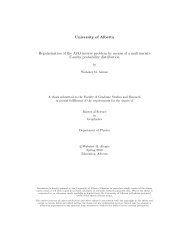Soner Bekleric Title of Thesis: Nonlinear Prediction via Volterra Ser
Soner Bekleric Title of Thesis: Nonlinear Prediction via Volterra Ser
Soner Bekleric Title of Thesis: Nonlinear Prediction via Volterra Ser
You also want an ePaper? Increase the reach of your titles
YUMPU automatically turns print PDFs into web optimized ePapers that Google loves.
4.2. ANALYSIS OF OPTIMUM FILTER LENGTH 52<br />
RMSE 2<br />
0.14<br />
0.13<br />
0.12<br />
0.11<br />
0.1<br />
0.09<br />
0 5 10 15<br />
Filter Length<br />
(a)<br />
RMSE 1<br />
0.28<br />
0.26<br />
0.24<br />
0.22<br />
0.2<br />
(b)<br />
0 5 10 15<br />
Filter Length<br />
Figure 4.1: Optimum filter length for the data in Figure 4.2. (a) RMSE2 . (b)<br />
RMSE1.<br />
ergy (Figure 4.4(b)). Note that this figure shows the prediction <strong>of</strong> the optimum<br />
filter length determined with RMSE2 in Figure 4.1(a). The minimum value for the<br />
RMSE in that example is 6. The prediction for filter length p = 15 is good but the<br />
result is not as good as in the optimum case with p = 6 (Figure 4.5(a)). Noise is<br />
also modeled and incorporated in the predicted data (Figure 4.5(b)). At this point<br />
some inferences are in order. First, it is clear that the filter length is very important<br />
both to model the data and to reject the noise. However, it is not possible to com-<br />
pute RMSE2 for real situations; it can be used to estimate optimum filter length<br />
when working with synthetic examples where one has accessed to data free <strong>of</strong> noise.<br />
Practical experience in seismic data processing shows that one can easily compute<br />
the optimum filter length by trying different lengths and observe the amount <strong>of</strong><br />
coherent energy left in the error panel. At some point one can find a filter length









